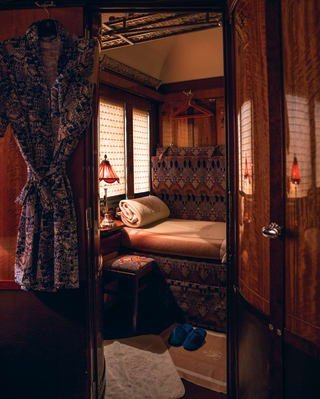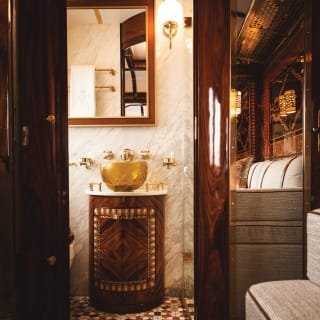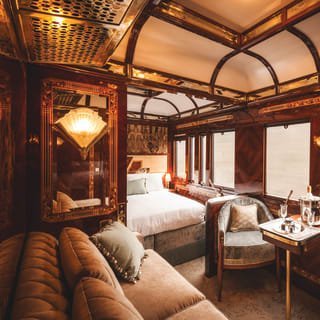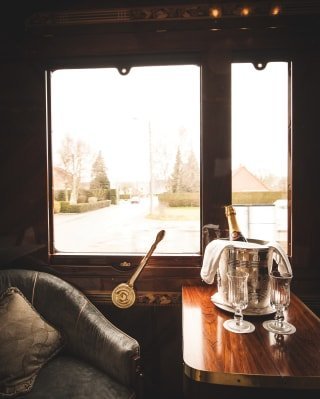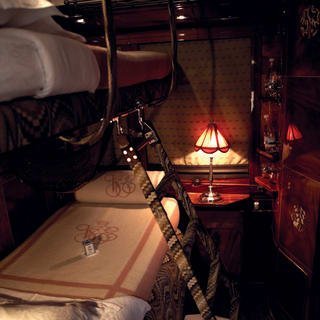-
Posts
1,935 -
Joined
-
Last visited
Content Type
Profiles
Forums
Gallery
Events
Everything posted by popeye2sea
-
Although I have no direct evidence for SR, I believe that the one of the mistakes is that the fore halyard knighthead should not be placed directly abaft the fore mast. The halyard will foul on the main stay. I think it should be offset to starboard a bit. I did this on my build. Another issue I have is the included casks/tubs for the cannons. I think these are supposed to be match tubs, but they look all wrong to me. The halyard tubs that are supplied are kind of strange, too. I am not planning on using any of those items. The hatch gratings are poorly modeled. And I am not sure about the arrangement or placement of the various knights on deck. Also, where, if any were present on the upper decks, would the pumps go. I assume somewhere near the main mast. There are no wedges or mast boots for any of the masts. I'm sure I am missing some items. Regards,
-
Thanks Bill, This build and modelling in general keeps getting pushed to the back of the priority list. Work, running a non-profit business and life in general keep getting in the way. The SR keeps staring at me from the top of my desk and I will get back to work on it eventually. The total build years has accumulated to over 40 now. Regards,
- 196 replies
-
- plastic
- soleil royal
-
(and 2 more)
Tagged with:
-
The ship I served in whilst in the Navy had fairleads for the signal halyards made from lignum vitae. 1985. Regards,
-
I have used UNI-Thread 3/0, 6/0, and 8/0 depending on the thickness of the rope being seized or whipped. Some of the UNI-Thread are flat monofilament and to my eye they do not produce a good looking seizing. The stuff with a rounder cross section works better. Of course you can always build up a few layers of the flat monofilament to compensate. A proper round seizing has 7 - 9 turns of marline followed by one fewer riding turns on top and then two crossing turns between the ropes being seized together. I has a very distinct appearance. For a flat seizing omit the riding turns and for a throat seizing omit the crossing turns. Regards,
-

Size of Rope and Serving for Stropping blocks
popeye2sea replied to Peter6172's topic in Masting, rigging and sails
I build up my strops on a serving machine. I pass a few turns of sewing thread between two hooks on the serving machine. The number of turns will determine the thickness of the finished strop. Then I serve between the hooks. The eyes formed at the ends where the turns passed around the hooks will be lashed together so that the strop forms a continuous loop. If necessary I then serve over the lashed eyes. The thickness I use for a particular block is pretty much just what looks good and in proportion to my eye. You can use variations on this method to make any variety of strop needed, for example long and short eye, eye and tail, etc. Regards, -
Well, the good news is that they are not really spliced. The cross rope is just tucked under one strand and passes straight through. Still a lot of eye splicing at the ends though. Regards,
-
Not to make things more confusing, but chain was not used for the entire length of most lines. A topsail sheet, for example, would be chain for the portion that would see the heaviest wear from the clew of the sail through the sheave at the yardarm and then to a point below where it turned through the cloverleaf block at the center of the yard. From there it was shackled to wire rope to lead down to near the deck where a rope tackle was shackled in for purchase. Regards,
-
Beautiful work! BTW, you are correct about the line. The tackle is what is referred to as the halyard. The part above it that runs over the cap and suspends the yard is called the tye. Regards
- 2,697 replies
-
- heller
- soleil royal
-
(and 9 more)
Tagged with:
-
The US paid tributes/bribes to the Barbary states for many years. Frequently, even after making a tribute agreement to secure protection from attack, the payor would find that the rulers (Deys of Algiers, Tunis or Bey of Tripoli) would go back on the deal and demand further gifts and tributes. They would enslave the crew and ransom anyone whom they felt was important enough to demand payment for. They would even demand that ships be built for them as gifts. The Barbary pirates are the reason for the existence of USS Constitution. She and her sisters were built to counter the pirates. Regards,
-

Ropewalk: A Cordage Engineer's Journey Through History
popeye2sea replied to BenD's topic in Nautical/Naval History
Great video. Reminds me of my years as a signalman in the Navy. Did a lot of splicing of double braid and three strand flag halyard. Regards, -

Euro knotting tool
popeye2sea replied to Don Quixote's topic in Modeling tools and Workshop Equipment
Most often a knot will be at the end of a line, i.e: stopper knot, man rope knot, bell rope knot. Also a lot of decorative ropework will be knotted. However, a hitch or a bend joins two ropes. Hitches and bends are generally designed to be readily untie-able or loosened, Knots are designed to be more permanent. Splices, seizings and lashings are another story. There are very few actual knots employed in the rigging of ships. In a similar vein, there are very few ropes in the rigging. The two I mentioned above being the only ones I can think of at the moment. Plenty of lines, though. Regards, -

Euro knotting tool
popeye2sea replied to Don Quixote's topic in Modeling tools and Workshop Equipment
True, but technically not a knot. Regards, -

scale
popeye2sea replied to Pirate's topic in Discussion for a Ship's Deck Furniture, Guns, boats and other Fittings
True enough, Pirate. However, if you're talking about using what's on hand you still have to make whatever you use work. For example, a larger block may not work with the line you are trying to put through it. The line may jump out of the sheave and jam in the block. Plus, ships did usually carry a supply of spare parts and the carpenter was always standing by to fashion something out of spare stock. For scale model work you have to take into consideration just how much bigger you are choosing to go. Will it still adhere to the impression of scale you are trying to achieve or will it look completely out of place? I am curious as to why you ask the question in the first place. Are you trying to justify using out of scale parts on your build? Why not just do it the right way from the start? Regards, -

scale
popeye2sea replied to Pirate's topic in Discussion for a Ship's Deck Furniture, Guns, boats and other Fittings
Can you please clarify your question? Are you talking about replacement parts used by the crew on an actual ship or are you asking about on a scale model using a larger part to replace a smaller one? Regards, -
Column 2 is the rig version; without sails, with all plain sails, with full sails including studdingsails. Column 4 is the page numbers in the plan where that line appears. Column 6 is the part numbers for attachment points for the line and the blocks needed for rigging. Regards,
- 2,697 replies
-
- heller
- soleil royal
-
(and 9 more)
Tagged with:
-
I personally build in exactly the fashion you describe. I am sure there are others that do the same. It's just a preference thing. In fact, I even fit the yards before proceeding to the next mast section. For me it makes sense because usually the lower sections rigging is often the furthest inboard and therefore I don't have to reach across other lines to belay. You will find what works best for you. Regards,
-
Just an FYI, on your mock up for the sail, the points that you have marked out for clew lines are actually for the bow lines. The clew line will come down to the lower corner of the sail, which is called the clew of the sail. Regards,
-
Yes, that is correct. Because of the rake of the mast and the offset of the topmast and lower mast the pivot point of the lower and upper yards will not align. But, then again, does it matter? With the yards perfectly horizontal any difference between where the clew of the sails ends up and the yard arm will be made up for with the sheet line. Where you really see a big problem is in the era of the spritsail top mast. Setting a spritsail topsail over a spritsail becomes nearly impossible with the yards braced around. Regards.
-
I have to disagree with you on that point. Most sailors were, quite literally, picked up off the street and trained on board, True, they became more valuable later in their careers, but they were very much expendable. A captain would be very lucky indeed to not suffer many casualties to the crew in the course of a cruise. Sailors and landsmen (untrained crew) were picked up in ports wherever they could be got. Safety and crew comfort for that matter was not even considered, The only reason a captain tried to limit his personnel losses to illness or death is because at some point the lack of crew would hamper his ability to work and fight the ship. Think about it like you can't operate your car without gas or oil. You don't feel bad if the oil leaks or you run out of gas. It just is a situation you have to deal with in order to keep you car running. Regards,
-
I think the omission of ladders to the poop deck are one of the errors in the kit. Also, I would be surprised if there were railings on those gangways. If any, I would make them from rope supported by stanchions. Safety was not a concern back then. Sailors were considered part of the equipage of the ship. If you lost or broke a part (person), oh well, replace it. Regards,
-
I think it is important to note that stuns'ls were only used in light airs and probably not used when a lot of tacking or maneuvering was anticipated. Also, since they are bent on to separate yards it should not have been too difficult to dip one end of the yard around to the other side of the plain sail when changing over on to the opposite tack. All you would need to do is slack the halliard until the yard lowered to the point where a seaman on the lower yard could hand the stuns'l yard around. Regards,
About us
Modelshipworld - Advancing Ship Modeling through Research
SSL Secured
Your security is important for us so this Website is SSL-Secured
NRG Mailing Address
Nautical Research Guild
237 South Lincoln Street
Westmont IL, 60559-1917
Model Ship World ® and the MSW logo are Registered Trademarks, and belong to the Nautical Research Guild (United States Patent and Trademark Office: No. 6,929,264 & No. 6,929,274, registered Dec. 20, 2022)
Helpful Links
About the NRG
If you enjoy building ship models that are historically accurate as well as beautiful, then The Nautical Research Guild (NRG) is just right for you.
The Guild is a non-profit educational organization whose mission is to “Advance Ship Modeling Through Research”. We provide support to our members in their efforts to raise the quality of their model ships.
The Nautical Research Guild has published our world-renowned quarterly magazine, The Nautical Research Journal, since 1955. The pages of the Journal are full of articles by accomplished ship modelers who show you how they create those exquisite details on their models, and by maritime historians who show you the correct details to build. The Journal is available in both print and digital editions. Go to the NRG web site (www.thenrg.org) to download a complimentary digital copy of the Journal. The NRG also publishes plan sets, books and compilations of back issues of the Journal and the former Ships in Scale and Model Ship Builder magazines.





